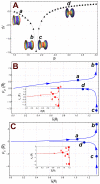Inhomogeneous Canham-Helfrich Abscission in Catenoid Necks under Critical Membrane Mosaicity
- PMID: 37755218
- PMCID: PMC10534449
- DOI: 10.3390/membranes13090796
Inhomogeneous Canham-Helfrich Abscission in Catenoid Necks under Critical Membrane Mosaicity
Abstract
The mechanical effects of membrane compositional inhomogeneities are analyzed in a process analogous to neck formation in cellular membranes. We cast on the Canham-Helfrich model of fluid membranes with both the spontaneous curvature and the surface tension being non-homogeneous functions along the cell membrane. The inhomogeneous distribution of necking forces is determined by the equilibrium mechanical equations and the boundary conditions as considered in the axisymmetric setting compatible with the necking process. To establish the role played by mechanical inhomogeneity, we focus on the catenoid, a surface of zero mean curvature. Analytic solutions are shown to exist for the spontaneous curvature and the constrictive forces in terms of the border radii. Our theoretical analysis shows that the inhomogeneous distribution of spontaneous curvature in a mosaic-like neck constrictional forces potentially contributes to the membrane scission under minimized work in living cells.
Keywords: catenoidal necks; inhomogeneous spontaneous curvature; stress on curved fluid membranes.
Conflict of interest statement
The authors declare no conflict of interest.
Figures







References
Grants and funding
LinkOut - more resources
Full Text Sources
Miscellaneous

